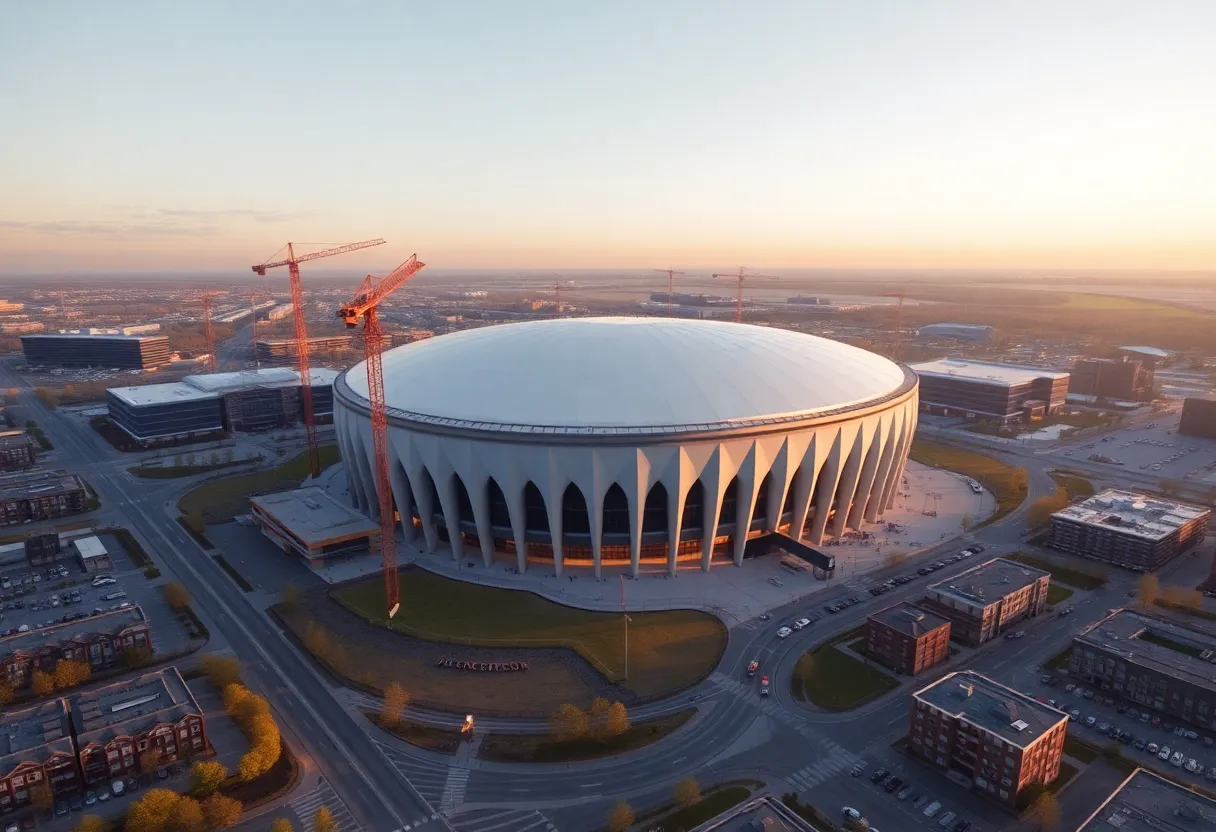Arlington Heights, Illinois, September 10, 2025
News Summary
A Chicago NFL team has confirmed plans to build a privately financed fixed‑roof domed stadium and a surrounding mixed‑use district on a 326‑acre suburban site. The full development is projected as roughly a $5 billion investment, with the stadium portion about $2 billion and seating for 65,000–70,000 fans. Project leaders say construction could generate tens of thousands of construction jobs and significant statewide economic impact, and that stadium construction will proceed without state funding. Plans include retail, housing, a hotel, parkland, planned commuter rail access, expanded roads and extensive approvals and studies before groundbreaking.
Major privately financed domed stadium and mixed‑use district planned for Arlington Heights
In a move described as a once‑in‑a‑generation opportunity to create a world‑class venue and entertainment district, a $5 billion privately funded development is proposed for the former Arlington International Racecourse site in Arlington Heights. The plan calls for a fixed‑roof domed stadium seating about 65,000 to 70,000 fans, paired with a surrounding mixed‑use district that includes retail, restaurants, housing, a hotel and park space. The site spans roughly 326 acres.
The project would deliver 56,000 construction jobs during the build and create about 9,000 permanent jobs once operational. It is projected to generate $10 billion in statewide economic impact. The stadium portion is estimated at about $2 billion in construction cost, with total site development closer to $5 billion. Financing is planned to be entirely private for stadium construction, with no state funding expected for the stadium; public incentives could support infrastructure and site improvements as needed. A potential mega‑project bill in the state capital could back site infrastructure and public improvements as part of the broader plan.
The 326‑acre site being redeveloped was previously used as a major racetrack. The ownership group purchased the property in 2023 for $197 million. Current plans include direct Metra train access and expanded parking, with new infrastructure designed to improve access and tailgating. The project also calls for a vibrant district around the stadium with space for retail, housing, a hotel, and park areas. The plan envisions ongoing traffic and infrastructure studies to guide decisions as approvals proceed.
Local authorities have signed a memorandum of understanding with the project team as a foundation for discussions on property tax certainty and infrastructure contributions. If approvals move forward, groundbreaking could occur as soon as late 2025, with a possible opening in 2028. The venture would place a privately financed NFL‑level venue among a short list of similar projects elsewhere and would likely reshape the suburban landscape while becoming one of the largest construction efforts in the state’s history. The project team emphasizes that it is aimed at attracting marquee events such as major football championships, national tournaments, international soccer matches and large concert productions.
Project scope and surrounding district
The development blueprint includes a mixed‑use district surrounding the stadium, featuring components such as retail shops, restaurants, housing options, a hotel, and extensive parkland. Direct connections to regional rail and enhanced parking capacity are planned to improve accessibility and tailgating experiences. The plan envisions a cohesive campus that integrates sports, entertainment and urban living in a manner designed to attract large‑scale events beyond football.
Financing, timeline and approvals
Financing for the project is described as private for stadium construction, with assurances that no state dollars will fund the stadium. The pathway to approvals includes discussions on property tax certainty and infrastructure contributions, along with ongoing traffic and related studies. A possible state legislative package could support site infrastructure and public improvements. Groundbreaking is anticipated to occur in late 2025 if approvals are finalized, with an opening target around 2028.
Economic impact and job creation
Officials anticipate a sizeable economic imprint, with an estimated statewide impact of $10 billion and a construction workforce numbering in the tens of thousands. After completion, the project is expected to support thousands of permanent jobs, contributing to the region’s long‑term economic and employment landscape. The plan is also viewed as a potential catalyst for broader private investment in the surrounding suburban area.
Market context for Chicago construction
Industry observers describe the local market as operating under two realities: ongoing demand for large adaptive reuse and infrastructure projects alongside persistent challenges in securing financing amid fluctuating costs and high interest rates. Some sectors, such as multifamily, retail and industrial work, remain active, while office construction has weakened. Labor costs in the region are influenced by union wage standards, which can provide relative predictability, but capital availability and tariffs remain primary risks for large projects. Public incentives and innovative contracting approaches are increasingly used to improve feasibility in a volatile environment. The broader message from market participants is that fundamentals remain solid, but sustained progress will depend on financing conditions, policy clarity, and competitive project economics.
As plans move forward, stakeholders emphasize careful risk management and adaptability, with a focus on leveraging public incentives, evolving market conditions, and an ability to translate opportunities into groundbreakings. The planning phase includes ongoing studies and coordination with local authorities to ensure a cohesive, economically beneficial redevelopment that aligns with community goals and regional transportation improvements.
Frequently asked questions
What is proposed at the Arlington Heights site?
A privately financed domed stadium accompanied by a surrounding mixed‑use district on a 326‑acre site, including housing, retail, a hotel and park space.
How much is the total investment?
About five billion dollars in total, with the stadium portion around two billion and the remainder for site development and district features.
What is the timeline for construction?
Groundbreaking could occur as early as late 2025, with opening possibilities around 2028, subject to approvals and local agreements.
How many jobs would this create?
During construction, an estimated 56,000 jobs; after completion, about 9,000 permanent positions are anticipated.
Will state funds be used?
Stated to be privately financed for stadium construction; public incentives may support infrastructure and public improvements as part of a broader package.
What features are included?
A fixed‑roof domed stadium with direct Metra access, expanded parking, and a surrounding district featuring retail, housing, a hotel and park space.
What is the status with approvals?
A memorandum of understanding supports discussions on tax certainty and infrastructure contributions, with ongoing traffic and related studies as part of the process.
| Feature | Detail |
|---|---|
| Project scope | Privately financed domed stadium plus 326‑acre mixed‑use district including housing, retail, hotel and park areas |
| Estimated investment | Approximately $5 billion total; stadium around $2 billion |
| Location | 326-acre former Arlington International Racecourse site in Arlington Heights |
| Seating capacity | 65,000 to 70,000 |
| Jobs (construction) | About 56,000 jobs during construction |
| Jobs (operational) | About 9,000 permanent jobs after opening |
| Funding | Private financing for stadium; no state funding for stadium; potential public incentives for infrastructure |
| Transportation | Direct Metra access and expanded parking; new infrastructure for access and tailgating |
| Timeline | Groundbreaking possible in late 2025; opening potentially in 2028 |
Deeper Dive: News & Info About This Topic
Additional Resources
- Chicago Construction News: Chicago Bears Arlington Heights stadium project projected at $5 billion
- Wikipedia: Arlington Heights, Illinois
- WISH-TV: Chicago construction firm joins $105M mixed-use project in Westfield
- Google Search: Westfield mixed-use project Chicago
- RE Journals: Construction in Chicago betting big amid financing headwinds
- Google Scholar: construction financing Chicago
- Chicago Construction News: Chicago leads U.S. metros in drop in new apartment construction
- Encyclopedia Britannica: apartment construction
- Chicago Tribune: Obama Center construction $615 million, opening nears
- Google News: Obama Presidential Center construction





